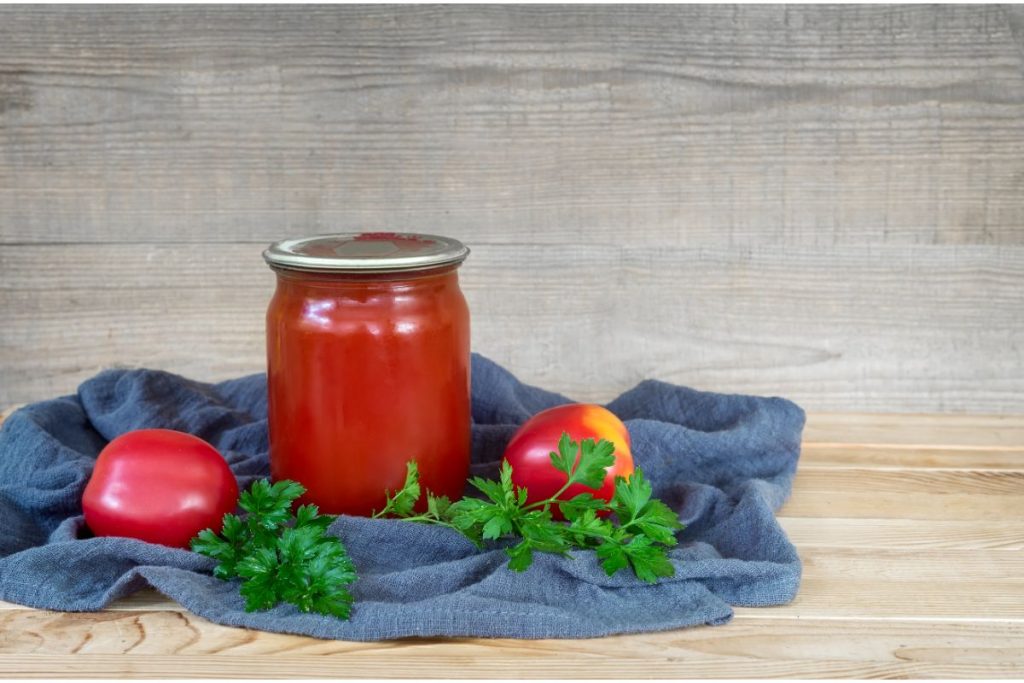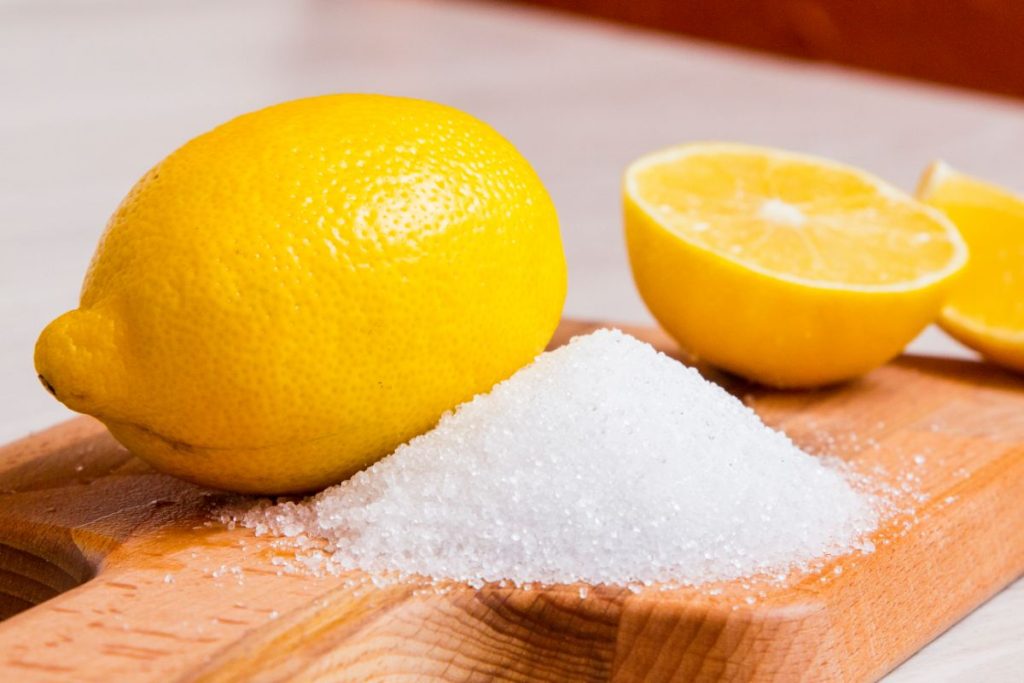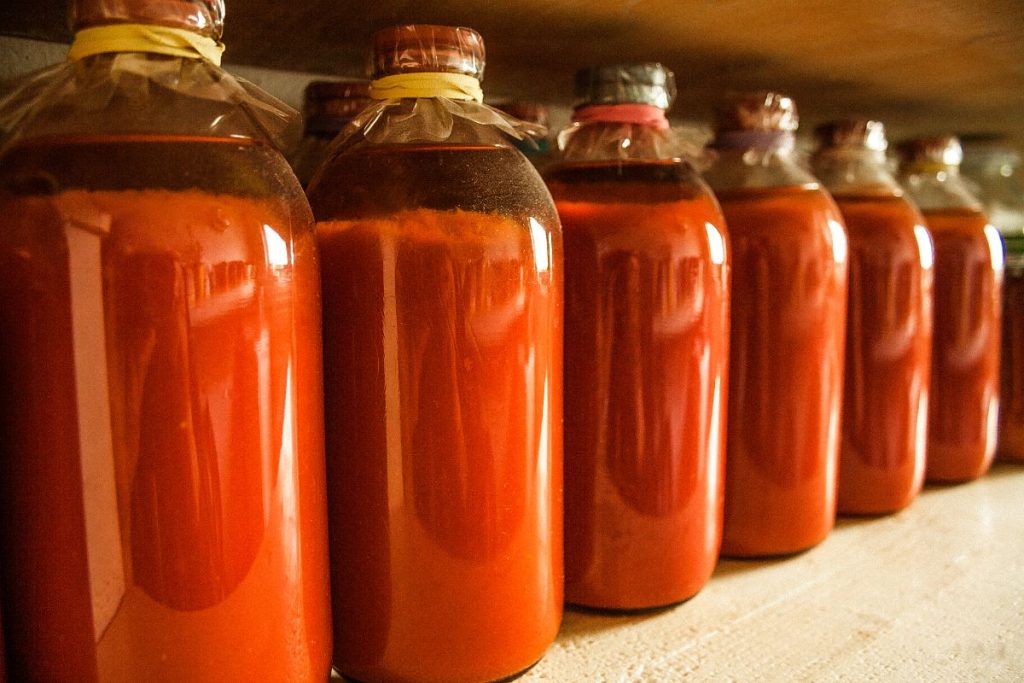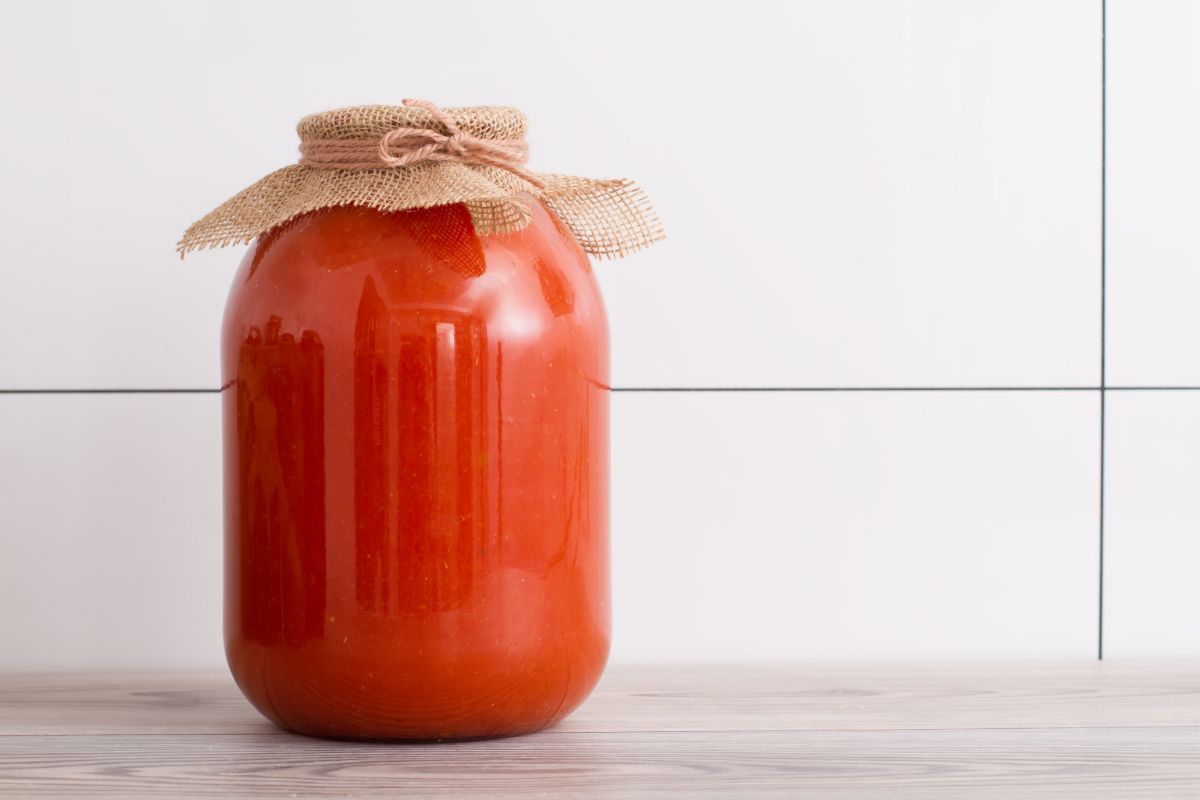Canning tomato juice begins by cooking whole tomatoes, crushing them, and extracting the juice. The tomato juice is then strained and mixed with bottled lemon juice to acidify it. Tomato juice can be processed using either a water bath canner or a pressure canner.
How to Pressure Can Tomato Juice
Pressure-canning tomato juice is a simple process. Aside from ripe tomatoes, all you need is bottled lemon juice! Having a food processor or juicer is optional but makes the process even easier.
Here’s how to pressure can tomato juice from red or yellow tomatoes:
- Ensure the canning jars, lids, and screw bands have been sanitized by running them through a dishwasher or handwashing them with soap and hot water.
- Sanitize canning jars in a stock pot of boiling water for 10 minutes. Keep the jars in the hot water until they are filled.
- Prepare the pressure canner per the manufacturer’s instructions, adding 2-4 inches of water and the canning rack. Place it on the stove over low heat with the lid off to warm the water.
- Sort and wash tomatoes under running water. Trim off the leaves and vines and cut tomatoes into quarters, removing the core.
- Add 1 pound of tomatoes to a saucepan and place over high heat. Crush the tomatoes to extract some of the juice and bring to a boil. Continue to slowly add the remaining tomatoes, crushing and stirring them into the boiling tomato mixture.
- Allow the tomatoes to simmer at a rolling boil for five minutes after you add all the tomato pieces.
- Transfer the tomato mixture from the saucepan and press the tomato juice through a food mill or strainer to remove the skin and seeds.
- Transfer the juice back into a pot and bring to a boil.
- Add a few tablespoons of bottled lemon juice into each pint or quart jar. Add a teaspoon of canning salt to each jar, if desired.
- Fill jars with hot tomato juice, leaving ½-inch headspace.
- Wipe the rims of the jars and apply lids and screw bands until fingertip tight.
- Using canning tongs, place the sealed jars on the jar rack inside the pressure canner.
- With the weight off or the valve open, turn the heat to high and let the canner vent steam for ten minutes.
- After ten minutes, put the weight on or close the valve and allow the pressure to build to the recommended level:
Processing time and pressure for tomato juice in a dial-gauge pressure canner:
| Altitude (ft) | 0 – 2,000 | 2,001 – 4,000 | 4,001 – 6,000 | 6,001 – 8,000 |
| Pints (20 mins) | 6 lbs | 7 lbs | 8 lbs | 9 lbs |
| Quarts (15 mins) | 11 lbs | 12 lbs | 13 lbs | 14 lbs |
Processing time and pressure for tomato juice in a weighted-gauge pressure canner:
| Altitudes (ft) | 0 – 1,000 | 1,001 + |
| Pints (20 mins) | 5 lbs | 10 lbs |
| Quarts (15 mins) | 10 lbs | 15 lbs |
- Process pints for 20 minutes and quarts for 15 minutes. While quarts are larger, they take less time because they are processed with more pressure.
- After processing, turn the heat off and let the canner cool naturally. Once the canner pressure reaches zero, open the canner lid carefully.
- Use canning tongs to move the jars to a cushioned countertop to cool in a draft-free location for 12-24 hours.
- Remove the screw bands once the jars are cool, and inspect the jars to ensure a proper seal. Sealed jars will have lids that do not flex up and down when pressed.
- Label and store sealed jars in a cool, dry place. Refrigerate and use any unsealed jars within 3 days.

How Long Do You Process Tomato Juice When Canning?
In a pressure canner, pints take 20 minutes, and quarts take 15 minutes to process. In a water bath canner, pints take 35-50 minutes, and quarts take 40-55 minutes to process.
What are the Best Tomatoes for Canning Tomato Juice?
The best tomato variety for making tomato juice is Roma tomatoes (also known as Italian or plum tomatoes). Only select large, fully ripe tomatoes for canning to ensure the juice is tasty and has a natural sweetness. The flavor of the juice before canning will remain after canning, which is why home canners should avoid canning unripe or sour tomatoes.
Print
Water Bath Canning Tomato Juice Recipe
- Total Time: 70 – 90 minutes
Description
Canned tomato juice is a great item to have in the pantry, and a water bath canner makes it so easy to prepare.
Ingredients
- 23lbs fresh tomatoes
- Bottled lemon juice
- Canning salt (optional)
Instructions
- Ensure your jars have been sanitized by running them through a dishwasher or handwashing them with soap and hot water, and rinse well.
- Sanitize the canning jars in boiling water for at least 10 minutes and keep them in the hot water until they are ready for filling.
- Fill the water bath canner with warm water and heat the water while you prepare the tomato juice.
- Wash the tomatoes and remove the stems, vines, and cores. Cut the tomatoes into quarters.
- Cook the tomatoes in a stockpot over high heat and bring the mixture to a rolling boil.
- Boil the mixture for at least 5 minutes before straining.
- Press the tomato juice through a food mill or a fine-mesh strainer to remove any skin, seeds, or other debris. Transfer the strained juice back to the pot and once again bring it to a boil.
- Add a few tablespoons of bottled lemon juice to the bottom of each canning jar. Add 1 teaspoon of salt to each quart jar, and 1/2 teaspoon of salt for each pint, if desired.
- Use a canning funnel to fill the jars with the hot tomato juice. Leave ½ inch headspace.
- Wipe the rims of the jars and seal the jars with lids and screw bands. Screw the bands on until they are fingertip tight.
- Load the cans onto the jar rack and lower the rack into the prepared canner. Add water if needed to get the water level to 1 inch above the tops of the jars.
- Once the jars are in the canner, heat the water to a rolling boil and cover the canner. Process for the time required per your elevation:
Processing for Pints:
- 0 – 1,000ft: 35 minutes
- 1,001 – 3,000ft: 40 minutes
- 3,001 – 6,000ft: 45 minutes
- 6,000ft and up: 50 minutes
Processing for Quarts:
- 0 – 1,000ft: 40 minutes
- 1,001 – 3,000ft: 45 minutes
- 3,001 – 6,000ft: 50 minutes
- 6,000ft and up: 55 minutes
Post Processing
- Once processed, turn the heat off and remove the canner’s lid. Allow the jars to rest for 5 minutes.
- After 5 minutes, remove the hot jars from the boiling water bath with canning tongs jar and place the jars on a towel-covered countertop to cool.
- Do not retighten screw bands. Let the jars air cool for 12-24 hours. You should hear a popping sound as the jars seal during the cooling process.
- Once the jars are completely cool, remove the screw bands and check the seals.
- If the seal is indented, the jar is safe to label and store in a cool, dark place.
- If the seal isn’t indented, you can use a new lid and reprocess, or put the jar into the refrigerator and consume it within 3 days.
Notes
- 23 lbs of tomatoes are needed for a canner load of 7 quarts.
- 14 lbs of tomatoes are needed for a canner load of 9 pints.
- Prep Time: 15 minutes
- Canning Time: 35-55 minutes
- Cook Time: 20 minutes
Nutrition
- Serving Size: 1 cup
- Calories: 42kcal
- Sugar: 6.3g
- Sodium: 615mg
- Fat: 0.7g
- Saturated Fat: 0.1g
- Carbohydrates: 8.6g
- Fiber: 1g
- Protein: 2.1g
- Cholesterol: 0mg
Do You Have to Add Lemon Juice When Canning Tomato Juice?
Lemon juice must be added when canning tomato juice, whether using a pressure canner or a water bath canner.
The USDA guidelines were developed with recipes that included acidification via citric acid, so lemon juice or citric acid is necessary when following safe canning practices. Bottled lemon juice is recommended since it has a standard acidity level.

What is the Acidity of Tomato Juice?
The pH level of tomato juice is between 4.10 – 4.60, making it a bit less acidic than apple juice or honey. The shifting pH of tomato juice means it should always be acidified before canning.
Do You Have to Cook Tomato Juice Before Canning?
Tomato juice is boiled before canning. It is boiled before straining it and boiled again afterward. It is not recommended to can tomato juice that hasn’t been cooked.
What is the Shelf Life of Canned Tomato Juice?
The shelf life of canned tomato juice is up to 18 months. For the best taste and quality, it is best to consume canned tomato juice within 12 months. It is important to keep canned tomato juice in a cool, dry place away from direct sunlight to keep the juice from spoiling.

Where Can You Buy a Canning Kit for Tomato Juice?
Canning kits can easily be found at online retailers or locally in big box stores and hardware stores. It is a good idea for those new to home canning to purchase a canning kit that has all the necessary tools and equipment needed.

